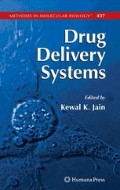Abstract
The inhalation route is seen as the most promising non-invasive alternative for the delivery of proteins; however, the short duration of activity of drugs delivered via this route brought about by the activities of alveolar macrophages and mucociliary clearance means there is a need to develop controlled release system to prolong the activities of proteins delivered to the lung. Polymeric materials such as (d,l)-poly(lactic glycolic acid) (PLGA), chitosan and poly(ethylene glycol) (PEGs) have been used for controlled release of proteins. Other systems such as liposomes and microcrystallization have also proved effective.
This chapter gives a more detailed understanding of these techniques and the manufacture of the delivery systems.
Access this chapter
Tax calculation will be finalised at checkout
Purchases are for personal use only
References
1. Crommelin, D., van Winden, E., Mekking, A. (2002) Delivery of pharmaceutical proteins. In: Aulton, M. E. (ed) Pharmaceutics: The science of dosage form design. Churchill Livingstone, Edinburgh, pp. 544–553.
2. Shen, W. C., Wan, J., Ekrami, H. (1992) Means to enhance penetration (3). Enhancement of polypeptide and protein absorption by macromolecular carriers via endocytosis and transcytosis. Adv. Drug Deliv. Rev. 8, 93–113.
3. Hilsted, J., Madsbad, S., Hvidberg, A., Rasmussen, M. H., Krarup, T., Ipsen, H., Hansen, B., Pedersen, M., Djurup, R., Oxenboll, B. (1995) Intranasal insulin therapy: the clinical realities. Diabetologia 38, 680–684.
4. Hollinger, M. A. (1985) Respiratory pharmocology and toxicology. Saunders, Philadelphia, pp. 1–20.
5. Shoyele, S. A., Slowey, A. (2006) Prospects of formulating proteins/peptides as aerosols for pulmonary drug delivery. Int. J. Pharm. 314, 1–8.
6. Edwards, D. A., Hanes, J., Caponetti, G., Hirach, J., Ben- Jebria, A. (1997) Large porous particles for pulmonary drug delivery. Science 276, 1868–1871.
7. Aquiar, M. M. G., Rodrigues, J. M., Cunha, A. S. (2004) Encapsulation of insulin-cyclodextrin complex in PLGA microspheres: a new approach to prolonged pulmonary insulin delivery. J. Microencapsul. 21, 553–564.
8. Koushik, K., Kompella, U. B. (2004) Preparation of large porous deslorelin-PLGA microparticles with reduced residual solvent and cellular uptake using supercritical CO2 process. Pharm. Res. 21, 524–535.
9. Courrier, H. M., Butz, N., Vandamme, Th. F. (2002) Pulmonary drug delivery systems: recent developments and prospects. Crit. Rev. Ther. Drug Carrier Syst. 19, 425–498.
Garcia-Contreras, L., Morcol, T., Bell, S. J. D., Hickey, A. J. (2003) Evaluation of novel particles as pulmonary delivery systems for insulin in rats. AAPS PharmSci. 5(2), Article 9.
Leach, C. L., Patton, J. S., Perkins, K. M., Kuo, M., Bueche, B., Guo, L., Bentley, M. D., (2002) PEG-insulin delivered by the pulmonary route provides prolonged systemic activity compared with insulin alone. Paper presented at 2002 AAPS meeting and exposition, Toronto, Ont., Canada, Nov. 10–14, 2002.
12. Kwon, J. H., Lee, B. H., Lee, J. J., Kim, C. W. (2004) Insulin microcrystal suspension as a long acting formulation for pulmonary delivery. Eur. J. Pharm. Sci. 22, 107–116.
13. Bennett, D. B., Tyson, E., Mah, S., de Groot, J. S., Hedge, J. S., Jerao, S., Teitelbaum, Z. (1994) Sustained delivery of detirelix after pulmonary administration of liposomal formulations. J. Control. Release 32, 27–35.
14. Hinds, K. D., Kim, S. W. (2002) Effects of PEG conjugation on insulin properties. Adv. Drug Deliv. Rev. 54, 505–530.
15. Kim, H. K., Chung, H. J., Park, T. J. (2006) Biodegradable polymeric microspheres with open/closed pores for sustained release of human growth hormone. J. Control. Release 112, 167–174.
16. Wang, J., Chua, K. M., Wang, C. H. (2004) Stabilization and encapsulation of human immunoblobulin G into biodegradable microspheres. J. Control. Release 271, 92–101.
17. Sharma, A., Sharma, U. S. (1997) Liposomes in drug delivery: progress and limitations. Int. J. Pharm. 154, 123–140.
18. Niven, R. W., Speer, M., Schreier, H. (1991) Nebulization of liposomes. II. The effects of size and modelling of solute release profiles. Pharm. Res. 8, 217–221.
19. Allen T. M. (1998) Liposomal drug formulations. Rationale for development and what we can expect for the future. Drug 56, 747–756.
20. Labiris, N. R., Dolovich, M. B. (2002) Pulmonary drug delivery. Part II: The role of inhalation delivery devices and drug formulations in therapeutic effectiveness of aerosolized medications. Br. J. Clin. Pharmacol. 56, 600–612.
Author information
Authors and Affiliations
Editor information
Editors and Affiliations
Rights and permissions
Copyright information
© 2008 Humana Press, a part of Springer Science + Business Media, LLC
About this protocol
Cite this protocol
Shoyele, S.A. (2008). Controlling the Release of Proteins/Peptides via the Pulmonary Route. In: Jain, K.K. (eds) Drug Delivery Systems. Methods in Molecular Biology™, vol 437. Humana Press. https://doi.org/10.1007/978-1-59745-210-6_6
Download citation
DOI: https://doi.org/10.1007/978-1-59745-210-6_6
Publisher Name: Humana Press
Print ISBN: 978-1-58829-891-1
Online ISBN: 978-1-59745-210-6
eBook Packages: Springer Protocols

